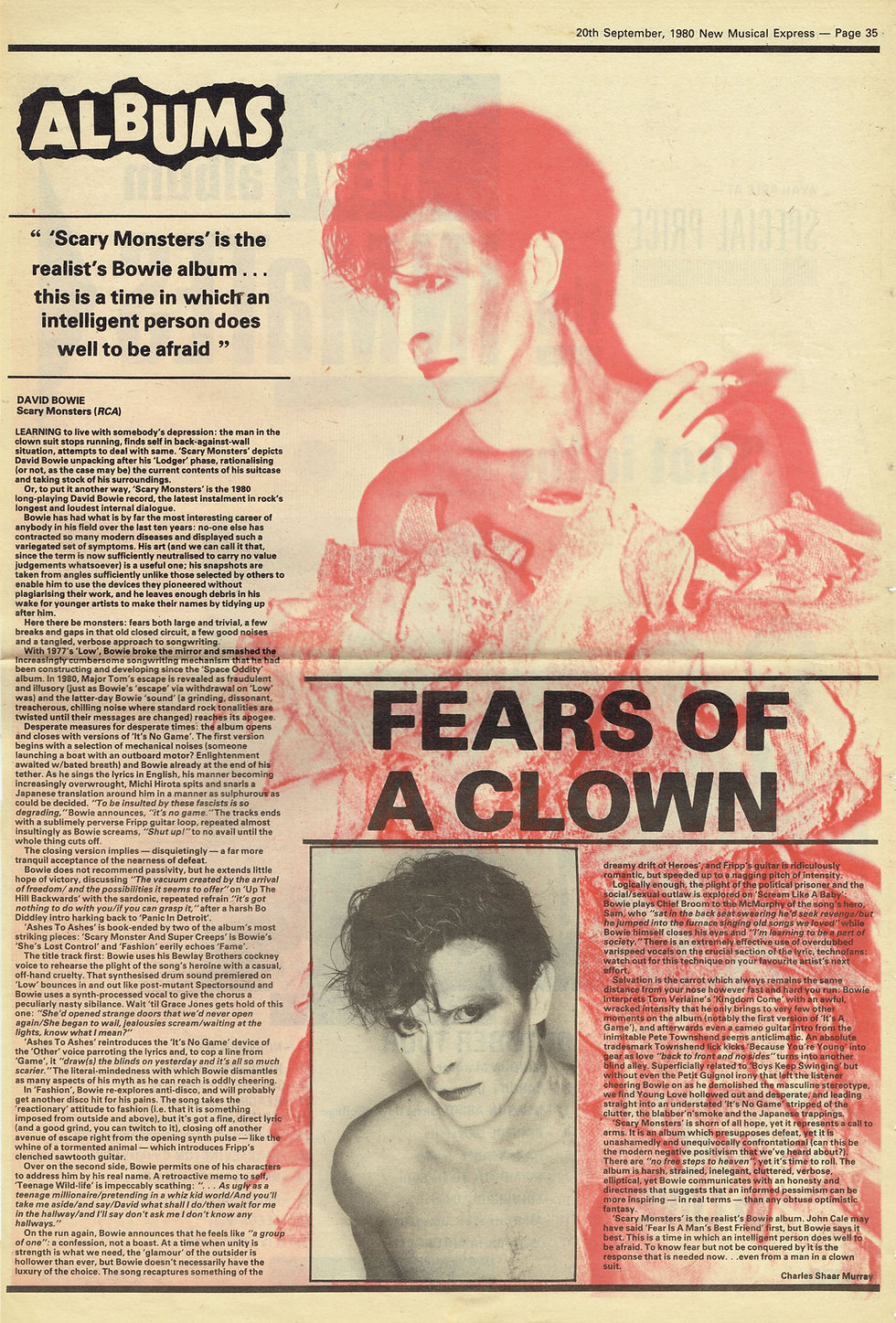David Bowie: "Scary Monsters (and Super Creeps)" Album (1980)
- David Bowie

- Sep 18, 1980
- 4 min read
Updated: Sep 23
David Bowie’s Scary Monsters (and Super Creeps) was released as an LP album in the UK by RCA Records (catalog number BOW LP 2) on September 19, 1980.

Commercial Performance:
UK: No. 1 for three weeks.
US: No. 12 on Billboard 200.
Certified Platinum (UK) and Gold (US) by 1981.
Album Overview
Title: Scary Monsters (and Super Creeps)
Artist: David Bowie
Label: RCA Records
Catalog Number: BOW LP 2 (UK)
Release Date: September 19, 1980 (UK); September 15, 1980 (US, with some regional variations)
Producer: David Bowie with Tony Visconti
Recording Locations: Power Station, New York City; Good Earth Studios, London; February–April 1980
Genre: Art rock, new wave, post-punk
Length: 45:38 (original LP)
Context: This was Bowie’s 14th studio album and his final release with RCA, serving as a synthesis of his Berlin Trilogy (Low, “Heroes”, Lodger) and a precursor to his 1980s pop era with Let’s Dance (1983).
Background and Recording
Creative Context: After the experimental Berlin Trilogy (1977–1979), co-produced with Brian Eno, Bowie aimed to reconnect with a broader audience while retaining his artistic edge. Scary Monsters revisited past personas (e.g., Major Tom, Pierrot) and embraced the emerging new wave and post-punk movements.
Bowie called it a “culmination of everything I’d done up to that point,” blending introspection with commercial appeal.

Recording Process: Sessions spanned February to April 1980, with initial work at Power Station in New York and overdubs at Good Earth Studios in London.
Tony Visconti’s production brought a polished yet raw sound, using techniques like reversed tapes and multi-layered vocals.
Key collaborators included:Robert Fripp (King Crimson): Lead guitar, delivering jagged, avant-garde riffs.
Carlos Alomar: Rhythm guitar, a Bowie staple since the 1970s.
Dennis Davis: Drums, providing a funky, tight beat.
George Murray: Bass, anchoring the tracks.
Roy Bittan (E Street Band): Keyboards, adding a rock-infused texture.
Additional contributions from Pete Townshend (guitar and backing vocals on “Because You’re Young”) and Chuck Hammer (guitar synth).
Innovations: The album featured experimental production, such as Michi Hirota’s Japanese narration on “It’s No Game (Part 1),” reflecting Bowie’s interest in global influences.

Track Listing The original UK LP (BOW LP 2)
It’s No Game (Part 1) (4:15)A abrasive opener with Hirota’s narration and Fripp’s aggressive guitar.
Up the Hill Backwards (3:13)A paranoid, upbeat track about navigating fame.
Scary Monsters (and Super Creeps) (5:10)The title track, a dark, funky exploration of inner turmoil.
Ashes to Ashes (4:23)A melancholic revisit to Major Tom, with a haunting synth line and cryptic lyrics.
Fashion (4:46)A satirical new wave hit about societal trends.
Teenage Wildlife (6:51)A sprawling ballad critiquing imitation in music.
Scream Like a Baby (3:35)A dystopian synth-pop narrative.
Kingdom Come (3:42)A cover of Tom Verlaine’s song, raw and emotional.
Because You’re Young (4:51)A moody rocker with Townshend’s backing vocals.
It’s No Game (Part 2) (4:22)A calmer reprise with reversed narration.

Release Details Formats:
Vinyl LP (BOW LP 2, UK; BOW LP-1, US):
Tracks: As listed above.
Details: 33⅓ RPM black vinyl. UK pressing featured RCA’s orange label with “BOW LP 2” matrix. US version (BOW LP-1) had a different sleeve layout.
Sleeve: Gatefold cover with Brian Duffy’s iconic Pierrot photo, symbolizing Bowie’s fragmented personas. Inner sleeve included lyrics and credits.
Pressing: Manufactured at RCA’s Peterborough, UK plant, with European variants (e.g., Germany: PL 13647).
Cassette (PK 13647, UK; PK 1-3647, US):
Tracks: Same as LP, with reordered sequencing for tape flow.
Details: Included a color insert mimicking the LP sleeve.
8-Track Cartridge (Limited markets):
Tracks: Reordered for 8-track compatibility, rare today.
Details: Primarily US market.
Catalog Variations:
Japan: RCA RVP-5530 (with obi strip).
Australia: RCA VPL1 7175.
Canada: RCA CPL1-3647.
Release Strategy:
RCA positioned Scary Monsters as a major release, leveraging Bowie’s Berlin success and the new wave boom (e.g., Talking Heads, The Police).
Initial pressings included a limited poster, boosting early sales.
Released during a competitive 1980 season, alongside albums by The Pretenders and The Police.
Singles
Ashes to Ashes (August 1, 1980):
Catalog: RCA BOW 1 (UK 7”); BOW 12 (UK 12”).
B-sides: “Move On” and “Ziggy Stardust” (live, 12”).
UK No. 1, Bowie’s fastest-selling single.
Fashion (October 24, 1980):
Catalog: RCA BOW 2 (UK 7”); BOW 212 (UK 12”).
B-sides: “Scream Like a Baby” (7”) and extended mixes (12”).
UK No. 5.
Scary Monsters (and Super Creeps) (January 2, 1981):
Catalog: RCA BOW 3 (UK 7”).
B-side: “Because You’re Young.”
UK No. 20.

Reception
Critical Response:
Acclaimed upon release. Rolling Stone praised its “dazzling synthesis,” while NME called it “Bowie’s most cohesive since Diamond Dogs.”
Retrospective reviews (e.g., Pitchfork, 9.0/10) highlight “Ashes to Ashes” as a masterpiece.
Legacy Influence:
Shaped new wave and post-punk, influencing Duran Duran and The Cure.
“Ashes to Ashes” inspired covers and nods (e.g., The Weeknd’s 2025 “Dawn FM” synths).
The Pierrot imagery influenced 1980s fashion and videos.
Reissues:
1992: Rykodisc CD with bonus tracks (“Alabama Song,” “Space Oddity” live).
2007: EMI remaster with “Crystal Japan.”
2017: Parlophone box set with demos and Blu-ray audio.
Cultural Impact:
Featured in Stranger Things and The Perks of Being a Wallflower.
The “Ashes to Ashes” video won early MTV acclaim.
Critical Examination
Accuracy: Release date (September 19, 1980, UK) aligns with RCA records. US date (September 15) reflects regional rollout.





Comments